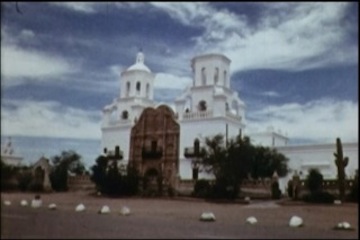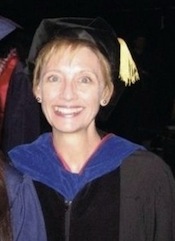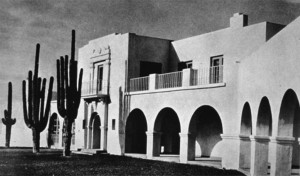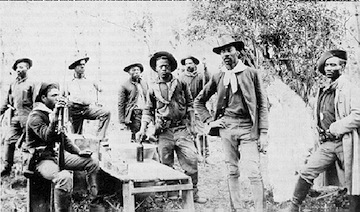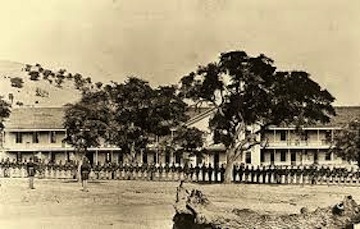T-Model Hank Rides and Tucson Boys Sing
Thanks to a grant from the federally backed National Film Preservation Foundation, two films from Arizona are assured preservation: one about a T-Model Ford tour guide, the other about a Tucson choir for boys. They join films the NFPF supported last year, about Yaqui ceremonies and a grand church mission complex from the 18th century.
n
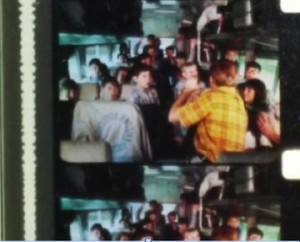
From “Ambassadors in Levis: The Tucson Arizona Boys Chorus”; University of Arizona Special Collections
Hank Rides Again, a film that the Arizona Development Board made in 1963 to encourage state residents to get in their cars and tour the state via its then-new highways, is 29 minutes of “regional charm,” says Jennifer Jenkins.
In the 16mm., stop motion film, the title character is a Model-T Ford that leads a tour of scenic Arizona: its cities, mountains, and deserts. It has great local appeal, says the University of Arizona archivist and scholar of literature and culture: “You can show it to a group of Arizonans sitting on grass in the summer time and they will eat it up.” But, she adds, “it also offers us documentation of all these places at a particular moment in time” – in the 1950s and ’60s, before the region’s huge economic expansion and population influx, the Sun Belt boom.
As goofy film and historical document, both, the film is now assured of preservation, thanks to a grant from the National Film Preservation Foundation. In June, the NFPF, an affiliate of the US Library of Congress, announced awards to 57 films that guarantee that the 32 institutions in 21 states that hold them will be able to preserve them by creating new negatives, film prints, and digital access copies.
The US Congress created the NFPF in 1996 as a charitable affiliate of the National Film Preservation Board of the Library of Congress. It has provided preservation support to 276 institutions and saved more than 2,223 films through grants and collaborative projects.
The film is one of four that Jenkins and colleagues at the Tucson, Arizona, institution have successfully petitioned the NFPF to help them safeguard. Each has a tale to tell.
Awarded an NFPF preservation grant this year, Ambassadors in Levis: The Tucson Arizona Boys Chorus, like Hank, is “very local Americana, which is part of its charm, of course,” says Jenkins. A University of Arizona production from the mid- to late-1960s, it depicts the activities of a cultural institution in the state. The choir formed in 1939 as a constructive activity for youths during the Great Depression, and was intended as a class-free organization, participants all dressed alike in Levi jeans and cowboy shirts and hats, one or two throwing lassos.
“Arizona’s Ambassadors in Blue Jeans” grew from eight original members to a company of around 30, performed at the 1950 Chicago World’s Fair, toured Europe in 1955 and Australia in 1960, and sang at the White House in 1963. The Chorus still exists, and has generations of former participants around the state.
Two other films held by the University of Arizona won NFPF preservation grants in the 2014 cycle, Mission San Xavier del Bac and Yaqui Degrazia. The latter is a 10-minute Technicolor film of the extraordinary Easter ceremony of the Yaqui indigenous group of Southwestern Arizona, which depicts an historic battle between Moors and Christians. Ettore “Ted” DeGrazia, an oil painter and sculptor, made the film, most likely in 1953, although the date remains uncertain. Born in a mining town in the region to Italian immigrant parents, he studied with the renowned Mexican painter and muralist Diego Rivera, then returned to Arizona and spent his career painting there. His Yaqui film evokes the Easter ceremony through a series of paintings he made, filmed, and narrated.
The University of Arizona Press in 1968 published its popular DeGrazia Paints the Yaqui Easter, with his illustrations, which he made from memory after watching each of the 40 days of the ceremony. (In September 2015 it is reissuing a biography of DeGrazia, DeGrazia: The Man and the Myths.)
Mission San Xavier del Bac presents the finest and most northern example of Mexican baroque architecture in the United States, “the crown jewel of the mission-church system that runs through Southern Arizona and Northern Sonora,” says Jenkins. “It’s just astonishing.” The film documents a restoration of the mission, which was constructed with outstanding murals and gold- and silver-leaf décor between 1775 and 1797 on a site established in 1692.
A staff photographer at the Arizona State Museum, Helge Teiwes, completed the short color film in 1968, and has long been acclaimed for her respectful portrait of the church’s Native American community of Tohono O’odham communicants. Among sequences she captured was one of the Indian Choir at San Xavier.
“When we get the film back from the lab,” says Jenkins, “I’m going to sit with Helge Teiwes and record her oral history of the film. She’s been around documenting the Southwest for that long, and I know she’ll have fascinating things to say.”
The films that Jennifer Jenkins and her colleagues have successfully preserved for restoration illustrate the sometimes happenstance nature of the endeavor. A description of Jenkins’s job may make you want to become a moving-image archivist, if you’re not one already.
Some years ago, the four NFPF-preserved films were saved from a University of Arizona library “deselection” process – from being chucked out. Library staff looked to see which holdings were being used in teaching, and which not. As preparations were under way, says Jenkins, “someone said, ‘You need to talk to Jennifer Jenkins because she’ll blow a gasket.’
“Which she did.”
As she made the case for why the films were worth keeping, she also rapidly began using the films in teaching. “We’re trying to build a culture where younger people, our students for example, start to expect to see films on film.”
She initially worried that 16mm films would not hold the attention of students of today; but not for long. The first time she screened a film in a silent-film course, she says, “the AV guy showed up with a really nice Pageant projector and threaded it up and we started watching. I was at the front of the room ready to narrate, if needed, and I realized the students weren’t looking at the screen; they were looking at the projector, because this was a technology that most of them had never seen.
“So we stopped, and rewound the film, and had the projectionist explain how to thread the projector. The students find this analog technology really fascinating. It’s stuff with moving parts! They really responded to the whole phenomenology of the projected, mechanical experience. They like the tick, tick, tick, and the flicker and the dust.”
Jenkins came late to film archiving. After undergraduate studies at the University of Arizona, she obtained her master’s degree from the University of Chicago and her doctorate in American literature and culture from the University of Arizona, then taught and published research in those areas – on such topics as representations of domesticity in American Gothic literature. Over time, she increasingly included film in her teaching and research. Looking for a project, one day she went to the local historical society and asked what they might have. Archivists described an unprocessed collection of films made by Charles Herbert, a Fox Movietone cameraman, and his wife, Lucile Herbert, who settled in Tucson in 1936. For their Western Ways Feature Company, which now is the subject of Jenkins’s project called Celluloid Pueblo: Western Ways Film Service and the Invention of the Postwar Southwest, the Herberts produced films as well as articles and photographs from the 1930s to the 1970s about the western United States and other parts of the Americas. “They did really interesting things, far ahead of their time in terms of cultural documentation,” says Jenkins.
The Arizona Historical Society holds the films along with some 143 boxes of scripts, stills, negatives, and business records. Jenkins led an effort to begin preserving and digitizing 10,000 feet of film that the Society stores in a freezer because it is on potentially flammable nitrate film stock. Among the material, in fact, is a reel of color, 35mm film that Herbert took of Ted DeGrazia.
But Jenkins recalls that when she first asked to see the Herberts’ films, “the then-archivist said, ‘Well, you have a PhD in English, so you’re not touching these films.’ I got mad and went down the street and enrolled in the library school.” In 2014 she earned her master’s in library science with a certificate in archival studies.
Cellulose nitrate film is a classified hazardous material, so “you don’t just give it to the 16mm-film house down the road; it’s a little more complicated,” she says. She has overseen the transfer of several of the films, including one called Spring Planting, aka “How to Move a Giant Saguaro,” which shows locals trekking into the desert, digging up a 12-ton saguaro cactus (the huge, columnar plants with arms akimbo are emblems of the Southwest), wrapping it in ticking mattresses and chains, hoisting it out of the ground, and carting it away with a crane to place it outside Grace Mansion in the foothills outside Tucson.
Also among the films preserved, to date, is Apache Scouts and Buffalo Soldier: a 939 Reunion, shot at Fort Huachuca, southeast of the University of Arizona. It began as a facility for segregated units of troops who joined the US Army after the Civil War and worked with Apache scouts. (The film is the subject of an essay by Jenkins in the current issue of The Moving Image, the journal of the Association of Moving Image Archivists.)
Jennifer Jenkins’ book on the Western Ways films is forthcoming from the University of Arizona Press, probably by March 2016. She and her University of Arizona colleagues will – as one of the stipulations of NFPF grants – make the NFPF-preserved films available to scholars, presenters, and film enthusiasts, in various forms. And the Historical Society plans to put the Western Ways films online (photographs from the collection are there, already).
In addition to all the above, Jenkins has been working on a set of films at the University of Arizona Special Collections, the Wolfgang Collection of travel films, which emphasizes Mexican material, and on another collection of films of early 20th century Tucson made by Andrew Ellicott Douglass. He was a polymath who came to the university in 1906 as an astronomer and devised the concept of dendrochronology, the dating of trees using tree rings and sun-spot records to date trees as well as such archaeological remains as the Anasazi ruins of Arizona and New Mexico.
Jennings has an essay, “The Philosophy of Marriage in North by Northwest,” forthcoming in Hitchcock and the Moral of the Story, a collection due out soon from the State University of New York Press. From 2003 to 2006, she curated Native Curiosity: Collecting Indian Arts in Territorial Arizona, for the Arizona Historical Society. She is developing an archive of amateur and locally-made films of the Arizona-Sonora borderlands. And each October she runs Tucson’s version of Home Movie Day.
A major part of her work involves curating the extensive, online American Indian Film Collection at the University of Arizona. In 2011, the now-late Fred MacDonald donated to the University a digital database of copies of 461 varied films relating to Native American life and culture that he placed with the Library of Congress.
The scans were in the now-discontinued Flash format, so the University has applied for funding to begin re-scanning the originals, this time in high definition, and to add such features as narrations by Native American people, in English and eventually indigenous languages such as Navajo. (Arizona has strong school and college programs in many of the languages of the state’s 21 federally recognized tribes.)
Native American and Hispanic students enrolled in a University of Arizona program that trains librarians to work with under-served populations are helping to refine the Native American film collection, too. They are performing content searches to identify depicted locations. Says Jenkins: “That’s been great. We’ve had Apache students who’ve worked on Apache films, and Zuni students who’ve worked on Zuni films. They can ask their grandparents and aunts and uncles.”
Earlier this year, says Jenkins, a student “went home one weekend, and was telling someone about what she was doing, and they said, ‘Oh, there are all these videos over at the high school.’ So she went over there and found a hundred VHS tapes of interviews with Zuni elders who have passed, and Zuni-language capture… All kinds of amazing stuff.”
Some of it is “material that people like me shouldn’t be seeing. It’s really intrinsic to the tribe and limited to people who have been through certain religious ceremonies. So we’ll help with the transfer but we can’t post it publicly.” In all projects relating to Native American film, she schools students in a 2006 document, Protocols for Native American Archival Material. Its recommendations include: ask tribes before posting material, and check whom it’s OK to identify. “It’s a really important ethical code to train archival students in, but also to follow, as project managers,” she says.
In processing the collection, archivists also are using an open-source content-management system developed in Australia, Mukurtu, whose developers describe it as “free, mobile, and open source platform built with indigenous communities to manage and share digital cultural heritage,” with permissions levels for viewing archival material.
Jenkins and her colleagues are seeking grant money to enable them to increase awareness of the Native American Film Collection, to alert members of the public that they may be holding film that archivists would like to add. “There is a lot of community video,” says Jenkins. “Everybody takes movies at pow-wows, and everybody films their council meeting and tribal government events. There is probably more material out there than we could process, even with an army of students.”
Some likely future additions to the collection will come from a currently active film-making scene for young Native American makers. Says Jenkins: “There’s a thriving young film making industry making fiction feature films; they populate Sundance, and there are native film festivals not just in the Southwest, but all over the world – aboriginal, indigenous film festivals. It’s a very active group, this millennial generation who’ve been making films on their phones and their tiny mini-DV cameras.”
Older material will be added, too: feature films and ethnographic films shot in the state, some no doubt of questionable taste
Tucson has a sizable retirement population as well as a large university-related one, and “we try to show some of the local pieces just to remind people to look for this material,” she says. “Every once in a while there’ll be the stereotypical suitcase in a garage somewhere” and thanks to Arizona’s dry climate, “they’re usually in reasonably good shape.”
— Peter Monaghan
Previous Post: Crumbling Movie Houses that Were Main Attractions
Next Post: Redress for A Giant of Costume Design

